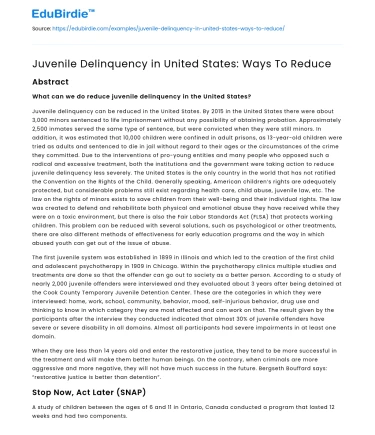Introduction
Juvenile delinquency remains a critical concern within the United States, characterized by the involvement of minors in criminal activities. This phenomenon not only disrupts societal harmony but also impedes the potential of young individuals to contribute positively to their communities. According to the Office of Juvenile Justice and Delinquency Prevention, thousands of juveniles are arrested annually, highlighting the urgency of addressing this issue. The multifaceted nature of juvenile delinquency requires a comprehensive approach that encompasses social, educational, and familial interventions. This essay explores effective strategies for reducing juvenile delinquency in the United States, focusing on early intervention programs, community involvement, and policy reforms. By examining real-life cases and expert opinions, this analysis aims to provide a nuanced understanding of how these strategies can mitigate juvenile crime rates and foster a safer society.
Early Intervention and Education
Early intervention and educational initiatives are paramount in curbing juvenile delinquency. Research indicates that early exposure to education and structured environments significantly reduces the likelihood of criminal behavior in adolescents. Programs such as Head Start and early childhood education initiatives have demonstrated success in equipping children with essential social and cognitive skills. According to a study by Schweinhart et al. (2005), participants in the Perry Preschool Project were less likely to engage in criminal activities and more likely to achieve higher educational attainment compared to their peers who did not participate in the program.
Save your time!
We can take care of your essay
- Proper editing and formatting
- Free revision, title page, and bibliography
- Flexible prices and money-back guarantee
Moreover, educational institutions play a crucial role in identifying at-risk youth and providing them with the necessary support and resources. Implementing mentorship programs and after-school activities can offer positive outlets for students, thereby reducing their chances of engaging in delinquent behavior. For example, the Big Brothers Big Sisters program has shown that youth with mentors are less likely to initiate drug use and exhibit violent behaviors (Tierney, Grossman, & Resch, 1995). While some critics argue that early intervention may not address all underlying issues, the benefits of such programs in fostering a supportive environment for youth are undeniable.
Community Involvement and Support Systems
Community involvement is another vital component in mitigating juvenile delinquency. By fostering a sense of belonging and responsibility, communities can significantly influence the behavior of young individuals. Grassroots organizations and community centers provide platforms for youth engagement, encouraging positive social interactions and skill development. Initiatives such as the Harlem Children's Zone have demonstrated the power of community-driven approaches in transforming the lives of at-risk youth by offering comprehensive support, including education, health, and social services.
Additionally, the role of family cannot be overstated. Supportive family environments, characterized by effective communication and parental involvement, are associated with lower rates of juvenile delinquency. Programs aimed at strengthening family bonds and parenting skills are instrumental in preventing youth crime. The Strengthening Families Program, for instance, has been successful in reducing substance abuse and improving family dynamics (Kumpfer et al., 2010). While community and familial interventions are not foolproof solutions, their collaborative effort plays a significant role in fostering a nurturing environment for juveniles.
Policy Reforms and Rehabilitation
Policy reforms and rehabilitation efforts are crucial in addressing the systemic issues contributing to juvenile delinquency. The juvenile justice system has evolved over the years, with a growing emphasis on rehabilitation rather than punishment. Legislative measures that promote alternatives to incarceration, such as diversion programs and restorative justice, have proven effective in reducing recidivism rates among juveniles. For example, the Juvenile Detention Alternatives Initiative (JDAI) has successfully reduced reliance on detention facilities while ensuring public safety and improving outcomes for youth.
Furthermore, rehabilitation programs tailored to the needs of juvenile offenders, such as counseling and vocational training, can facilitate their reintegration into society. The Missouri Model, which emphasizes rehabilitation within a therapeutic environment, has been praised for its success in reducing reoffending rates. Critics of policy reforms argue that they may lack the necessary resources and consistency to be effective. However, the positive outcomes associated with rehabilitation-focused approaches underscore their potential in transforming the juvenile justice system.
Conclusion
In conclusion, addressing juvenile delinquency in the United States requires a multifaceted approach that encompasses early intervention, community involvement, and policy reforms. Educational initiatives and mentorship programs provide essential support for at-risk youth, while community and family involvement foster a nurturing environment. Policy reforms focusing on rehabilitation rather than punishment hold promise in transforming the juvenile justice system and reducing recidivism rates. Despite challenges and criticisms, these strategies represent a comprehensive framework for mitigating juvenile crime and enhancing societal well-being. By investing in the potential of young individuals, society can pave the way for a safer and more prosperous future.






 Stuck on your essay?
Stuck on your essay?

